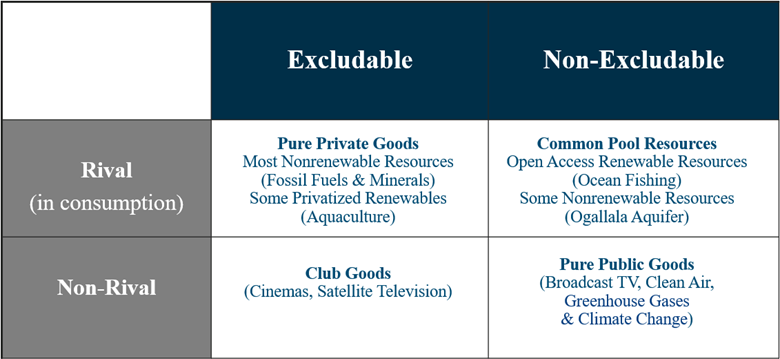There’s more than one kind of “non-rival” and “non-excludable”
The case for a three-by-three grid of goods
Economists often like to classify goods on a two-by-two grid: goods can be “Rival” or “Non-Rival” and they can be “Excludable” or “Non-Excludable.” Below is the grid we use in our introductory environmental economics course:
I think this is missing something. Or rather, it is conflating a few things: The categories of “Non-Rival” and “Non-Excludable” are each better thought of as a grouping of two different categories, and I’d prefer we taught this as a three-by-three.
Saying a good is “Non-Excludable” tells us that agents can’t be prevented from consuming it. But in many cases, we also care about whether they are forced to consume it or not. A high seas fishery is considered “Non-Excludable” because anyone can go fish there if they have the right vessel. Air quality is “Non-Excludable” in a fundamentally different way, in that everyone in the area will have to deal with it whether they want to or not.1 This difference does not come down to Rivalry, where we have traditionally appreciated a difference between these two goods. Public Radio is Non-Rival and Non-Excludable, but consumption is voluntary. Many congestion externalities are Rival and Non-Excludable, but we could reasonably consider consumption involuntary (say, for example, building evacuations). I contend there are really three components to the Excludability dimension: Excludable, Voluntary, and Involuntary.
The same is true for Rivalry. A good can be “Non-Rival” because people’s uses do not affect each other, like two people’s separate use of a large national park. But it could also be “Non-Rival” in that other people’s use is a benefit to each user, like at a midnight showing of The Rocky Horror Picture Show, where other people’s shenanigans are the whole point of attendance. These examples show two different kinds of club goods: There’s the golf club model, where the club maintains a course that each member can enjoy separately, and there’s the game store model, where the store sells a coordination device for people who want opportunities to play with other people. The same distinction matters for Non-Excludable goods. Goods like clean air and public libraries can be consumed (involuntarily or voluntarily) regardless of the consumption of others. But social media, a defining good of our time, depends on the participation of other people.2 Much of culture has these dynamics—you can’t be prevented from participating and your returns are increasing in the participation of others. So, there are really three components to the Rivalry dimension: Rivalrous, Neutral, and Complementary.
If you’re with me, here’s the new grid:3
Does this matter? Maybe, maybe not. I think the standard taxonomy is accurate, but missing in detail. But, of course, this new taxonomy still misses plenty of details. I would argue that adding these particular distinctions is worth it, given that many of the most interesting modern problems in economics are about goods that are involuntary or complementary. Climate change, the biggest topic of environmental economics research, differs from some traditional topics due to its involuntary nature. Yes, we can think of both fisheries and the atmosphere as common-pool resources, but overfishing and “free driving” under solar geoengineering have policy-relevant differences due to the ways atmospheric goods are “Involuntary”. And as networks and platforms become more important parts of the digital world and economy, the distinction between neutral and complementary goods becomes more important too. Whether or not you’re sold on teaching this differently, I hope thinking about how to categorize goods under this new taxonomy is at least thought provoking!
For these purposes, defensive investments count as “dealing with it.”
One could reasonably argue that social media could exclude people but chooses not to, so they are non-excluded but not nonexcludable. This could matter for some analysis, but in my view does not matter for all of it.
Major caveat to the new grid: I don’t love the names! Any suggestions on better names would be much appreciated.



